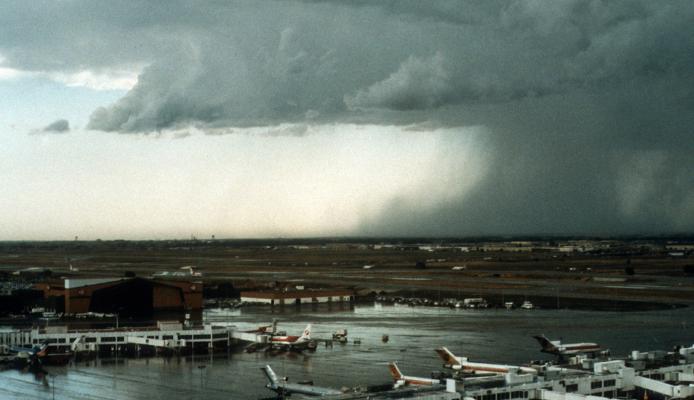Low-level wind shear has been identified as a leading cause or contributing factor in a significant number of aviation accidents. Since 1943, wind shear accidents are estimated to have been responsible for more than 1400 fatalities worldwide, including over 400 deaths in the United States during the 1973 – 1985 period. Research by NCAR and others in the late 1970s through the early 1990s, revealed that an intense localized weather phenomenon called a microburst is the most hazardous type of wind shear. In addition, significant low-level wind shear and turbulence can also be caused by rough terrain under certain meteorological conditions.
Research and Development Areas
Wind Shear created by Convective Storm Outflows
Convective storms can generate significant airflow features, including gust fronts, tornadoes, and microbursts. A microburst is characterized by precipitation falling below cloud base, a descending shaft of air, and an intense divergence of the horizontal wind field at the surface. The diverging pattern of the wind field is particularly hazardous since an aircraft encountering the microburst will initially experience a strong headwind, quickly followed by a tailwind with an associated loss of lift. Dry microbursts (without precipitation) can be particularly dangerous because there are fewer visual clues of the wind shear for pilots. The significance of the hazard, and the number of lives lost, led to the development and deployment of wind shear and microburst detection systems.
Terrain-induced Wind Shear
Air flowing around mountains, hills, valleys, and manmade obstructions can cause wind shear and turbulence in both clear air and cloudy conditions. Under certain meteorological conditions, the terrain-induced wind shear and turbulence can be strong enough to pose a hazard to aviation requiring the need for a wind shear and turbulence detection solution.
- Hong Kong Airport wind shear and turbulence alert system
- Juneau Airport wind shear and turbulence alert system
Wind Shear Detection and Alerting
In collaboration with other research organizations, NCAR/RAL developed systems that successfully address the low-level wind shear problem for the aviation community. These aviation safety systems deployed at airports utilize data from several sources, including anemometers near the runways and distributed around the airport region, Doppler radar and/or Doppler lidar, wind profilers and sodar, and weather prediction models. Windshear and turbulence alerts are typically provided to air traffic controllers, pilots, and airport meteorologists on both graphical and alphanumeric displays. Building on this research, several different commercial off-the-shelf technologies are available nowadays and deployed around the world for wind shear detection. Understanding the local environment and meteorology are key to the selection of an appropriate wind shear detection and alerting system.
